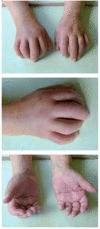Complex Regional Pain Syndrome or Limb Pain: A Plea for a Critical Approach
- PMID: 35837543
- PMCID: PMC9275500
- DOI: 10.2147/JPR.S351099
Complex Regional Pain Syndrome or Limb Pain: A Plea for a Critical Approach
Abstract
Most frequently, complex regional pain syndrome (CRPS) develops after a trauma and affects distal parts of the limbs. Early recognition and initiation of adequate treatment is crucial for a favorable outcome. On the other hand, misdiagnosing other disorders as CRPS is detrimental because more appropriate treatment may be withheld from the patients. Despite intensive research, a specific biomarker or paraclinical measure for CRPS diagnosis is still lacking. Instead, clinical criteria approved by the International Association for the Study of Pain (IASP) and latest adapted in 2019 are central for diagnosing CPRS. Thus, the CRPS diagnosis remains challenging with the risk of a "deliberate diagnosis" for unexplained pain, while at the same time a delayed CRPS diagnosis prevents early treatment and full recovery. CRPS is a diagnosis of exclusion. To clinically diagnose CRPS, a vigorous exclusion of "other diseases that would better explain the signs and symptoms" are needed before the patients should be referred to tertiary centers for specific pain treatment. We highlight red flags that suggest "non-CRPS" limb pain despite clinical similarity to CRPS. Clinical and neurological examination and paraclinical evaluation of a probably CRPS patient are summarized. Finally, we pinpoint common differential diagnoses for CRPS. This perspective might help CRPS researchers and caregivers to reach a correct diagnosis and choose the right treatment, regardless whether for CRPS mimics or CRPS itself.
Keywords: diagnostic criteria; differential diagnoses; misdiagnoses; paraclinical evaluation.
© 2022 Terkelsen and Birklein.
Conflict of interest statement
The authors report no conflicts of interest in this work.
Figures



Similar articles
-
External validation of IASP diagnostic criteria for Complex Regional Pain Syndrome and proposed research diagnostic criteria. International Association for the Study of Pain.Pain. 1999 May;81(1-2):147-54. doi: 10.1016/s0304-3959(99)00011-1. Pain. 1999. PMID: 10353502
-
IASP diagnostic criteria for complex regional pain syndrome: a preliminary empirical validation study. International Association for the Study of Pain.Clin J Pain. 1998 Mar;14(1):48-54. doi: 10.1097/00002508-199803000-00007. Clin J Pain. 1998. PMID: 9535313
-
Complex regional pain syndrome: are the IASP diagnostic criteria valid and sufficiently comprehensive?Pain. 1999 Nov;83(2):211-9. doi: 10.1016/s0304-3959(99)00104-9. Pain. 1999. PMID: 10534592
-
Complex regional pain syndrome - Autoimmune or functional neurologic syndrome.J Transl Autoimmun. 2020 Dec 24;4:100080. doi: 10.1016/j.jtauto.2020.100080. eCollection 2021. J Transl Autoimmun. 2020. PMID: 33490941 Free PMC article. Review.
-
Different Types of Pain in Complex Regional Pain Syndrome Require a Personalized Treatment Strategy.J Pain Res. 2023 Dec 27;16:4379-4391. doi: 10.2147/JPR.S432209. eCollection 2023. J Pain Res. 2023. PMID: 38162406 Free PMC article. Review.
Cited by
-
Multidisciplinary approach and the Self-Training Educative Pain Sensation (STEPS) model for managing orofacial complex regional pain syndrome.BMJ Case Rep. 2025 Apr 29;18(4):e263910. doi: 10.1136/bcr-2024-263910. BMJ Case Rep. 2025. PMID: 40306753 Free PMC article.
-
Modern Principles of Diagnosis and Treatment in Complex Regional Pain Syndrome.Dtsch Arztebl Int. 2022 Dec 27;119(51-52):879-886. doi: 10.3238/arztebl.m2022.0358. Dtsch Arztebl Int. 2022. PMID: 36482756 Free PMC article.
-
Complex Regional Pain Syndrome: Diagnosis, Pathophysiology, and Treatment Approaches.Cureus. 2024 Dec 24;16(12):e76324. doi: 10.7759/cureus.76324. eCollection 2024 Dec. Cureus. 2024. PMID: 39850174 Free PMC article. Review.
-
Author's response.Korean J Pain. 2025 Apr 1;38(2):215-217. doi: 10.3344/kjp.25057. Korean J Pain. 2025. PMID: 40159942 Free PMC article. No abstract available.
References
-
- Upadhyay J, Geber C, Hargreaves R, Birklein F, Borsook D. A critical evaluation of validity and utility of translational imaging in pain and analgesia: utilizing functional imaging to enhance the process. Neurosci Biobehav Rev. 2018;84:407–423. doi:10.1016/j.neubiorev.2017.08.004 - DOI - PMC - PubMed
LinkOut - more resources
Full Text Sources

